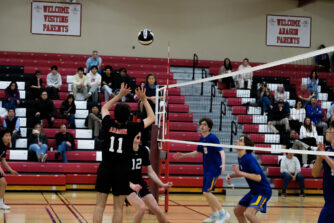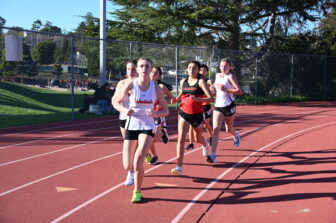For most high school athletes, their sports career don’t begin with varsity — they must work their way up through junior varsity. Although varsity teams generally get more attention as they get the opportunity to advance to CCS playoffs, those teams and their achievements don’t begin at the varsity level. And although there is a gap in levels of play between the two teams, a lot of work goes in to create the success of a varsity team.
History teacher and JV football coach Steve Henderson believes that the gap between varsity and JV comes from the different speeds of play.
“Varsity games in all sports I think go faster than JV games,” he says. “I think it’s a safe statement to make as a generalization that varsity teams have a greater awareness of what they’re supposed to do next, and they play faster.”
The ability to have “a greater awareness” doesn’t come from anywhere. It comes from practice and experience, which players get through playing on JV teams. Talent does not just appear one day — it is created through practice.
Junior JV basketball player Evan Andriola feels that playing on a JV team prepares athletes to play at the varsity level: “It gives you a whole year to develop your own skills individually and as a team more, so you can be prepared to help the team on varsity next year.”
Development of skills on and off the court are a large part of being involved on a JV team. Players who would not be given as much playing time on varsity are instead rewarded with larger amounts of playing time, the ability to build up skill levels, leadership experiences and playing time while performing on the JV level.
Sophomore forward and captain of the JV boys soccer team Marcos Alvarez-Barragan describes the benefits of playing on a JV team: “Scoring goals, and the playing time I get. Also being the captain, because that wouldn’t have been an opportunity for me on varsity.”
Leadership experiences provided on JV creates a higher level of maturity for future varsity players. Important aspects of the game such as leadership and maturity sometimes come from talented underclassmen who make varsity or upperclassmen who decide to play their last one or two years to represent their school. However, it is important to recognize how taking pride in playing for JV opens doors such as being able to be the captain of a team or how to communicate better with others.
Zoë Wilson, a sophomore JV water polo player, explains how her pride increased throughout the course of her season. “I felt the most school pride towards the end of the season because in the beginning I was really new to the sport and I didn’t really know much about it,” she says. “Towards the end I found it was really fun and then I realized that I could give back to my school by playing a sport.”
Not only does participating at the JV level allow athletes to gain leadership skills, but it also allows them to obtain the confidence and desire to continue their careers into the varsity level. Being able to contribute to one’s school team, and taking pride in doing so, is something many players begin to realize at the JV level. Leaders on varsity can also provide motivation to JV players, inspiring athletes to compete in order to develop their skills to the best of their ability.
Junior JV basketball player Jack Belzer describes the respect he has for varsity players and his outlook on what traits role models possess: “They’re on varsity for a reason and you want to develop aspects of your game that would match theirs. There can be players that you look up to as well.”
Jaclyn Aquino, a senior captain of the varsity Women’s Soccer team at Aragon spoke about pride and how she felt about being able to be a leader this past season. Aquino says, “I definitely became more of a leader once I was chosen for captain, and it made me realize that many people were looking up to me. It made me want to push and strive to do better.”
Players like Aquino set examples for JV athletes and serve as role models for athletes. This is always a great motivator for players and having people to look up to gives younger participants that extra push of incentive to be successful. Although there may be upperclassmen on a JV team who have more experience, they don’t always have to be the role models.
“What we try to do is pick the guys who we see are there the most, who the players respect the most, and make them the leaders,” explains Henderson, “Instead of trying to say that just because players are older that they are the leaders.”
Henderson’s explanation of the process of picking a captain for the JV team sums up what qualities embody a leader. The path for choosing a leader begins at the JV level, and so does Aragon athletes’ hard work, dedication and commitment that carries them to their future successes.



